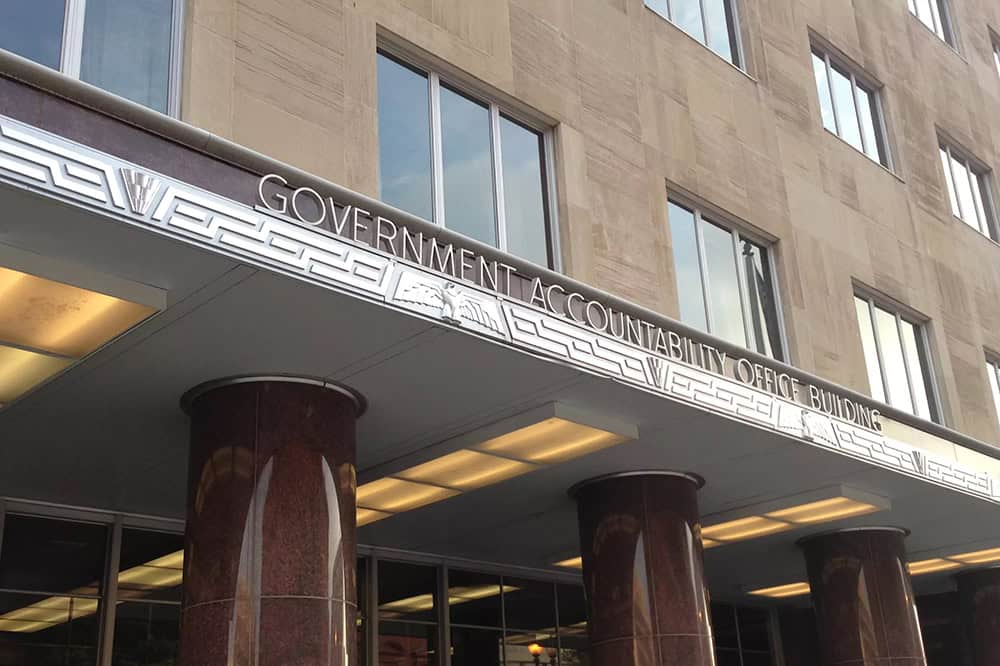As Deficits Widen to a 7-Year High, Americans Urge Leaders to Start Managing the Debt
The October 2019 Fiscal Confidence Index, Modeled after the Consumer Confidence Index, is 54 (100 is Neutral)
NEW YORK (October 29, 2019) — With the gap between federal spending and revenues widening to a deficit approaching $1 trillion, the vast majority of Americans want the president and Congress to address the national debt, according to the Peter G. Peterson Foundation’s monthly Fiscal Confidence Index. The October Fiscal Confidence Index, modeled after the Consumer Confidence Index, is 54 (100 is neutral), indicating that voters are highly concerned about the debt and the fiscal path of the nation.
Voters are seeking leadership on this issue, as nearly eight in ten across party lines say Congress and the president should spend more time addressing the debt. That sentiment is echoed by 73 percent of voters who want the national debt to be a top-three priority for the president and Congress, including 67 percent of Democrats, 75 percent of independents and 78 percent of Republicans.
These concerns are also felt by majorities of voters across all age groups, with 60 percent of 18 to 44 year olds, 57 percent of 45 to 64 year olds and 56 percent of people older than 65 years believing that the United States is on the wrong track in addressing the national debt.
“Last year’s deficit was nearly $1 trillion and it’s on track to continue to grow rapidly, so voters are rightfully concerned about what our fiscal outlook means for our future,” said Michael A. Peterson, CEO of the Peterson Foundation. “Americans understand that our unsustainable debt trajectory and interest costs threaten our ability to address national priorities. They are urging leaders to take action on available solutions to ensure greater opportunity and quality of life for the next generation.”
The Fiscal Confidence Index measures public opinion about the national debt by asking six questions in three key areas:
- CONCERN: Level of concern and views about the direction of the national debt.
- PRIORITY: How high a priority addressing the debt should be for elected leaders.
- EXPECTATIONS: Expectations about whether the debt situation will get better or worse in the next few years.
The survey results from these three areas are weighted equally and averaged to produce the Fiscal Confidence Index value. The Fiscal Confidence Index, like the Consumer Confidence Index, is indexed on a scale of 0 to 200, with a neutral midpoint of 100. A reading above 100 indicates positive sentiment. A reading below 100 indicates negative sentiment.
Fiscal Confidence Index Key Data Points:
- The October 2019 Fiscal Confidence Index value is 54. (The September value was 52. The August value was 52.)
- The current Fiscal Confidence Index score for CONCERN about the debt is 57, indicating deep concern about the debt. The score for debt as a PRIORITY that leaders must address is 29, indicating that Americans want elected leaders to make addressing long-term debt a high priority. The score for EXPECTATIONS about progress on the debt is 77. The Fiscal Confidence Index is the average of these three sub-category scores.
- For a description of the complete methodology, see the Appendix below.
The Peter G. Peterson Foundation commissioned this poll by the Global Strategy Group and North Star Opinion Research to survey public opinion on the national debt. The nationwide poll included 1,002 U.S. registered voters, surveyed by telephone between October 21, 2019 and October 24, 2019. The poll has a margin of error of +/- 3.1%. The poll examined voters’ opinions on the national debt, political leadership, and America’s fiscal and economic health.
Detailed poll results can be found online at: www.pgpf.org/FiscalConfidenceIndex.
About the Peter G. Peterson Foundation
The Peter G. Peterson Foundation is a nonprofit, nonpartisan organization that is dedicated to increasing public awareness of the nature and urgency of key fiscal challenges threatening America’s future, and to accelerating action on them. To address these challenges successfully, we work to bring Americans together to find and implement sensible, long-term solutions that transcend age, party lines and ideological divides in order to achieve real results. To learn more, please visit www.pgpf.org.
APPENDIX: Fiscal Confidence Index Methodology and Questions
- The Fiscal Confidence Index is released monthly by the Peter G. Peterson Foundation.
- The Fiscal Confidence Index value is based on six questions in three categories.
- As is done with the Consumer Confidence Index, the first step in calculating the Fiscal Confidence Index is determining the “Relative Value” for each question. This calculation is made by taking the positive response for each question and dividing it by the sum of the positive and negative responses. Each question was asked on a four-point scale, and answers were weighted according to intensity, with the strongest responses counting twice as much as the middle responses (“much” better or worse answers count twice as heavily as “somewhat” better or worse answers).
- The scores for the Concern, Priority, and Expectations categories are determined by averaging the scores derived from the two questions in each category.
- The Fiscal Confidence Index value is converted from the Relative Value to place it on a scale on which 100 indicates equal positive and negative sentiment, while values below 100 indicate negative sentiment and values above 100 indicate positive sentiment.
- The questions are as follows:
| CONCERN (57) | |||
|---|---|---|---|
| Thinking about our national debt over the last few years, would you say your level of concern has increased or decreased? ◊ Is that a lot or just a little? |
October 2019 | September 2019 | August 2019 |
| Increased a lot | 37% | 39% | 36% |
| Increased a little | 22% | 24% | 24% |
| Decreased a little | 11% | 11% | 12% |
| Decreased a lot | 10% | 6% | 8% |
| (No change) | 19% | 18% | 17% |
| (Don’t Know/Refused) | 2% | 2% | 3% |
| INCREASED (NET) | 58% | 63% | 60% |
| DECREASED (NET) | 21% | 17% | 20% |
| When it comes to addressing our national debt, would you say things in the United States are heading in the right direction or do you think things are off on the wrong track? ◊ Do you feel that way strongly or just somewhat? |
October 2019 | September 2019 | August 2019 |
| Right direction-Strongly | 16% | 15% | 16% |
| Right direction-Somewhat | 16% | 15% | 13% |
| Wrong track-Somewhat | 17% | 18% | 17% |
| Wrong track-Strongly | 41% | 40% | 41% |
| (Neither/Mixed) | 6% | 7% | 8% |
| (Don’t Know/Refused) | 5% | 5% | 5% |
| RIGHT DIRECTION (NET) | 31% | 30% | 30% |
| WRONG TRACK (NET) | 58% | 58% | 58% |
| PRIORITY (29) | |||
|---|---|---|---|
| Some people say that addressing the national debt should be among the president and Congress’ top 3 priorities. Do you agree or disagree? ◊ Do you feel that way strongly or just somewhat? |
October 2019 | September 2019 | August 2019 |
| Strongly agree | 46% | 47% | 44% |
| Somewhat agree | 27% | 28% | 31% |
| Somewhat disagree | 12% | 11% | 12% |
| Strongly disagree | 8% | 8% | 7% |
| (Don’t Know/Refused) | 7% | 5% | 6% |
| AGREE (NET) | 73% | 75% | 75% |
| DISAGREE (NET) | 20% | 19% | 19% |
| And when it comes to our national debt, do you think it is an issue that the president and Congress should spend more time addressing or less time addressing? ◊ Would you say a lot (more or less) time or just a little? |
October 2019 | September 2019 | August 2019 |
| A lot more time | 49% | 54% | 52% |
| A little more time | 30% | 26% | 30% |
| A little less time | 6% | 6% | 5% |
| A lot less time | 4% | 4% | 3% |
| (The same amount of time) | 7% | 6% | 6% |
| (Don’t Know/Refused) | 5% | 3% | 4% |
| MORE TIME (NET) | 79% | 79% | 82% |
| LESS TIME (NET) | 10% | 11% | 8% |
| EXPECTATIONS (77) | |||
|---|---|---|---|
| And thinking about our national debt over the next few years, do you expect the problem to get better or worse? ◊ Is that much (better or worse) or just somewhat (better or worse)? |
October 2019 | September 2019 | August 2019 |
| Much better | 9% | 11% | 10% |
| Somewhat better | 17% | 15% | 15% |
| Somewhat worse | 27% | 27% | 28% |
| Much worse | 32% | 34% | 33% |
| (No change) | 6% | 5% | 6% |
| (Don’t know/Refused) | 10% | 7% | 8% |
| BETTER (NET) | 26% | 26% | 25% |
| WORSE (NET) | 58% | 61% | 61% |
| And when it comes to our national debt, are you optimistic or pessimistic that the United States will be able to make progress on our national debt over the next few years? ◊ Would you say you are very (optimistic or pessimistic) or just somewhat? |
October 2019 | September 2019 | August 2019 |
| Very optimistic | 16% | 18% | 17% |
| Somewhat optimistic | 31% | 29% | 29% |
| Somewhat pessimistic | 22% | 19% | 21% |
| Very pessimistic | 21% | 24% | 22% |
| (Neither/Mixed) | 5% | 5% | 6% |
| (Don’t Know/Refused) | 5% | 4% | 5% |
| OPTIMISTIC (NET) | 47% | 47% | 46% |
| PESSIMISTIC (NET) | 43% | 44% | 43% |
Further Reading
Growing National Debt Sets Off Alarm Bells for U.S. Business Leaders
Debt rising unsustainably threatens the country’s economic future, and a number of business leaders have signaled their concern.
How Much Can the Administration Really Save by Cutting Down on Improper Payments?
Cutting down on improper payments could increase program efficiency, bolster Americans’ confidence in their government, and safeguard taxpayer dollars.
What Is R Versus G and Why Does It Matter for the National Debt?
The combination of higher debt levels and elevated interest rates have increased the cost of federal borrowing, prompting economists to consider the sustainability of our fiscal trajectory.


